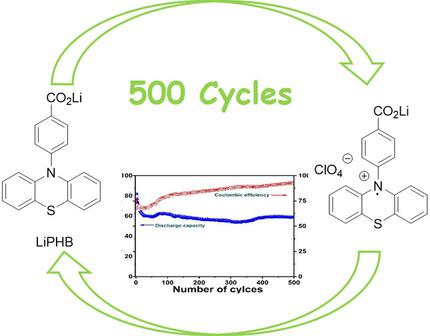当前位置:
X-MOL 学术
›
ChemSusChem
›
论文详情
Our official English website, www.x-mol.net, welcomes your
feedback! (Note: you will need to create a separate account there.)
Reversible Anion Insertion in Molecular Phenothiazine-Based Redox-Active Positive Material for Organic Ion Batteries.
ChemSusChem ( IF 7.5 ) Pub Date : 2020-04-14 , DOI: 10.1002/cssc.201903559 Murugesan Rajesh 1, 2, 3 , Franck Dolhem 3, 4 , Carine Davoisne 1, 2, 3 , Matthieu Becuwe 1, 2, 3
ChemSusChem ( IF 7.5 ) Pub Date : 2020-04-14 , DOI: 10.1002/cssc.201903559 Murugesan Rajesh 1, 2, 3 , Franck Dolhem 3, 4 , Carine Davoisne 1, 2, 3 , Matthieu Becuwe 1, 2, 3
Affiliation

|
The increasing demand for rechargeable batteries induces the development of greener and better devices. Significant advances have been made in the last decade together with a renewed interest in organic electrode materials. Thus, stable electron-donating organic materials are candidates for "greener" molecular batteries (metal-free). Herein, we report the design of a monomeric p-type N-substituted phenothiazine salt as an efficient anionic host structure working reversibly in a dual-ion cell configuration using lithium as the negative electrode. Investigation of different electrolyte salts, LiClO4 , LiPF6 , and LiTFSI in PC (propylene carbonate), reveals that lithium 4-(10H-phenothiazin-10-yl) benzoate (LiPHB) exhibits a high operating potential (≈3.7 vs. Li+ /Li) corresponding to a one-electron process with a reversible specific capacity of 86 mAh g-1 in a LiClO4 -based electrolyte, exhibiting an extraordinary cycling stability over 500 cycles at 0.2 C. Such impressive results are rendering LiPHB a promising scaffold for developing next-generation molecular organic batteries.
中文翻译:

基于分子吩噻嗪的有机离子电池氧化还原活性正极材料中的可逆阴离子插入。
对可充电电池的不断增长的需求促使人们开发出更环保,更好的设备。在过去的十年中,随着对有机电极材料的重新关注,取得了重大进展。因此,稳定的供电子有机材料是“绿色”分子电池(不含金属)的候选材料。在本文中,我们报告了单体p型N-取代的吩噻嗪盐的设计,该盐是一种有效的阴离子主体结构,可在使用锂作为负极的双离子电池结构中可逆地工作。对PC(碳酸亚丙酯)中不同的电解质盐LiClO4,LiPF6和LiTFSI的研究表明,4-(10H-吩噻嗪-10-基)苯甲酸锂(LiPHB)具有较高的工作电势(≈3.7vs.
更新日期:2020-04-14
中文翻译:

基于分子吩噻嗪的有机离子电池氧化还原活性正极材料中的可逆阴离子插入。
对可充电电池的不断增长的需求促使人们开发出更环保,更好的设备。在过去的十年中,随着对有机电极材料的重新关注,取得了重大进展。因此,稳定的供电子有机材料是“绿色”分子电池(不含金属)的候选材料。在本文中,我们报告了单体p型N-取代的吩噻嗪盐的设计,该盐是一种有效的阴离子主体结构,可在使用锂作为负极的双离子电池结构中可逆地工作。对PC(碳酸亚丙酯)中不同的电解质盐LiClO4,LiPF6和LiTFSI的研究表明,4-(10H-吩噻嗪-10-基)苯甲酸锂(LiPHB)具有较高的工作电势(≈3.7vs.











































 京公网安备 11010802027423号
京公网安备 11010802027423号